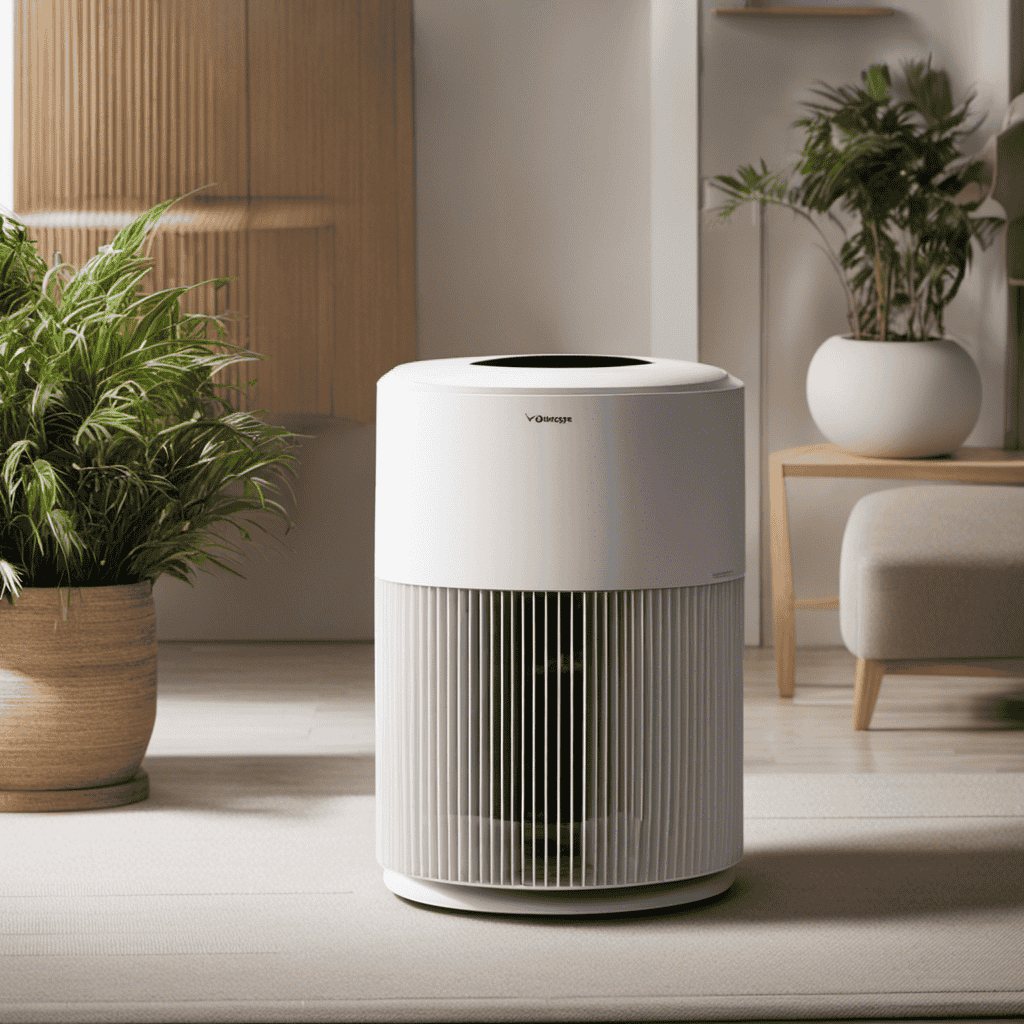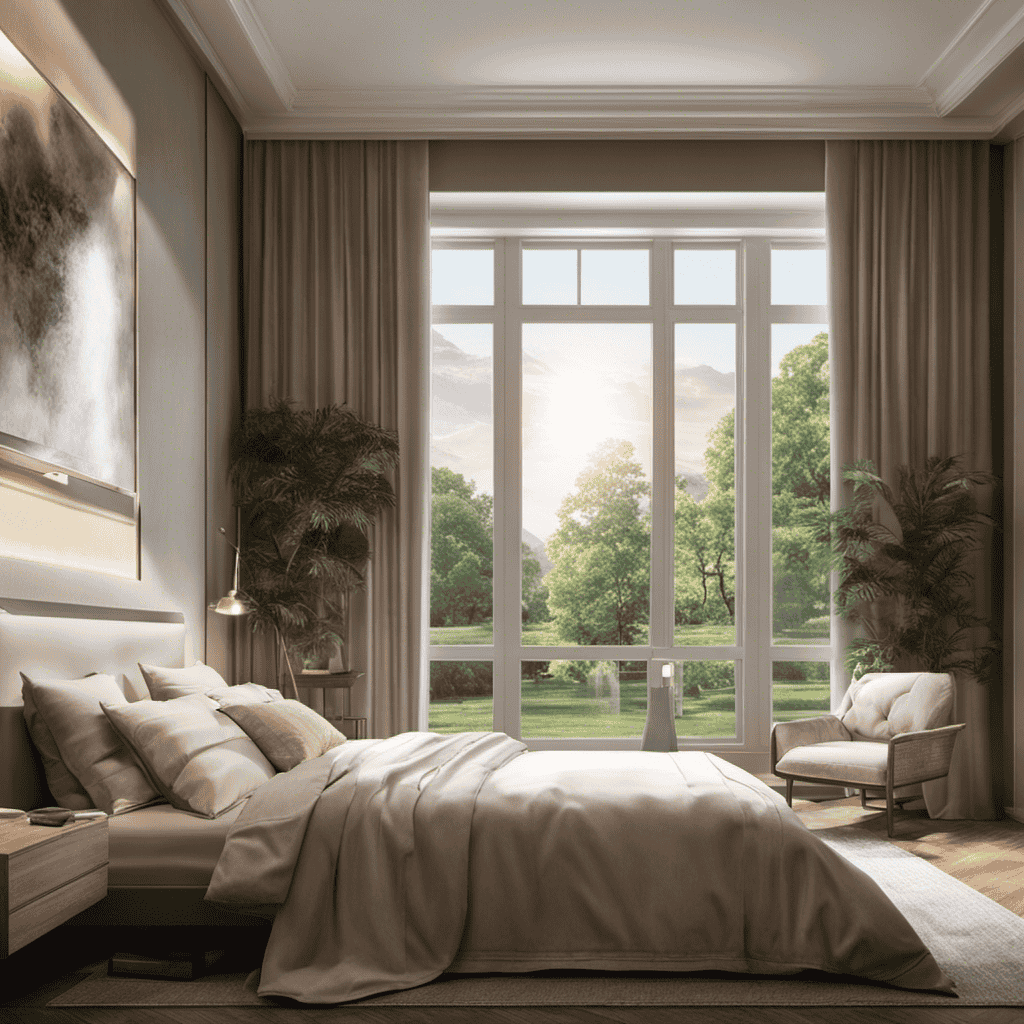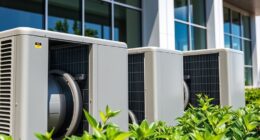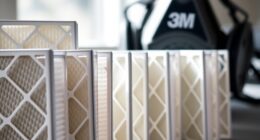I have recently been looking into air purifiers in order to find the most suitable one for my requirements. The variety of options available can be quite overwhelming.
But fear not, because in this article, I’ll break down the key factors you should consider when choosing an air purifier. From understanding different purification technologies to finding the right size and filter efficiency, I’ll guide you through the decision-making process.
So let’s dive in and find out what type of air purifier should I get.
Key Takeaways
- Factors to consider when choosing an air purifier include the size of the room, specific pollutants to eliminate, layout of the room, and understanding air quality measurements.
- Understanding air purification technologies such as HEPA filters for capturing allergens, UV-C light for killing microorganisms, and the potential risks of ozone generators.
- Safety precautions and potential dangers associated with ozone generators, including their harmful effects on humans and pets.
- The importance of considering room size and coverage area when choosing an air purifier, including the filtration efficiency of HEPA filters and the effective coverage range for optimal performance.
Key Factors to Consider
When choosing an air purifier, it’s important to consider key factors such as the size of the room and the specific pollutants you want to eliminate.
The layout of your room plays a vital role in determining the effectiveness of an air purifier. If you have an open floor plan or multiple rooms, you may need a purifier with a higher coverage area.
Additionally, understanding air quality measurements is crucial. By measuring the air quality in your room, you can identify the specific pollutants that need to be targeted. This will help you choose an air purifier with the right filters and technologies to effectively eliminate those pollutants.
Now that we have covered the key factors to consider, let’s move on to understanding air purification technologies.
Understanding Air Purification Technologies
When it comes to air purification technologies, two popular options to consider are HEPA filters and UV-C light.
HEPA filters are highly effective at removing particles as small as 0.3 micrometers, making them ideal for capturing allergens and other airborne contaminants.
On the other hand, UV-C light works by emitting ultraviolet radiation that damages the DNA of microorganisms, effectively killing them.
Additionally, it’s important to understand ozone generators and their potential risks. Ozone generators produce ozone, a gas that can be harmful to human health, so it’s crucial to use them with caution and follow the manufacturer’s guidelines.
HEPA Vs. UV-C
If you want to choose between HEPA and UV-C air purifiers, you should consider their effectiveness in filtering out different types of pollutants. Here is a comparison between the two:
-
Pros and Cons of HEPA Filters:
- Pros: HEPA filters are highly effective in removing airborne particles such as dust, pollen, pet dander, and mold spores. They can capture particles as small as 0.3 microns with an efficiency of 99.97%.
- Cons: HEPA filters do not eliminate odors, gases, or volatile organic compounds (VOCs). They require regular filter replacements to maintain their effectiveness.
-
Comparison between HEPA and UV-C Filters:
- HEPA filters primarily focus on physical filtration, trapping particles in a dense filter media.
- UV-C filters use ultraviolet light to destroy microorganisms, including bacteria, viruses, and mold. However, they may not be as effective in removing larger particles.
Considering these factors, you can choose the air purifier that best suits your needs and preferences.
Now, let’s move on to the next section where I will explain ozone generators.
Ozone Generators Explained
Now let’s delve into the purpose and function of ozone generators. Ozone generators are air purifiers that produce ozone gas to remove pollutants and odors from the air. However, it is important to understand the dangers associated with ozone. While ozone can be effective in eliminating certain contaminants, it can also be harmful to humans and pets if not used properly. It is crucial to take ozone safety precautions when using ozone generators, such as ensuring proper ventilation and using them in unoccupied spaces. Here is a table summarizing some key ozone dangers and safety precautions:
| Ozone Dangers | Safety Precautions |
|---|---|
| Can cause lung irritation and breathing problems | Use ozone generators in unoccupied spaces |
| Can worsen asthma and respiratory conditions | Ensure proper ventilation |
| Can produce harmful byproducts when reacting with other chemicals | Follow manufacturer instructions |
Understanding these ozone dangers and taking the necessary safety precautions is essential for safe and effective use of ozone generators. Now, let’s move on to the next section where we will discuss the size and coverage area considerations when choosing an air purifier.
Size and Coverage Area
When it comes to choosing an air purifier, it’s important to consider the size and coverage area of the room you want to purify. Room size compatibility is crucial because an air purifier that is too small may not effectively clean the air in larger spaces, while one that is too large may be unnecessary and waste energy.
Additionally, understanding the effective coverage range of an air purifier is essential to ensure that it can adequately purify the air in your room, eliminating pollutants and allergens effectively.
Room Size Compatibility
Finding an air purifier that’s compatible with the size of your room is essential. You want to make sure that the purifier can effectively clean the air in your space without being too small or too large.
Here are three factors to consider when determining room size compatibility and filtration requirements for an air purifier:
-
Room Size: Measure the square footage of your room to determine the appropriate purifier size. Different purifiers have different coverage areas, so knowing the size of your room will help you choose the right one.
-
Air Changes Per Hour (ACH): Consider the ACH rating of the air purifier. This refers to how many times the purifier can clean the air in your room in one hour. A higher ACH rating is ideal for larger rooms or spaces with higher pollution levels.
-
Filtration Efficiency: Look for an air purifier with a high-efficiency particulate air (HEPA) filter. HEPA filters can remove 99.97% of particles as small as 0.3 microns, including dust, pollen, pet dander, and mold spores. This level of filtration is crucial for maintaining clean and healthy air in your room.
Effective Coverage Range
To ensure the air purifier effectively cleans the air in your room, measure the square footage and choose one with a coverage area that matches your room size. Room size compatibility is crucial because if the air purifier is too small, it may not effectively clean the air in larger rooms, and if it is too large, it may be unnecessarily expensive and take up more space than needed.
When deciding between a compact or large air purifier, consider the size of your room. A compact air purifier is ideal for smaller rooms, such as a bedroom or office, while a larger one is better suited for larger spaces, like a living room or open-concept area.
Here is a table outlining the coverage area recommendations for different room sizes:
| Room Size | Compact Air Purifier | Large Air Purifier |
|---|---|---|
| Small (up to 150 sq ft) | ✔️ | |
| Medium (151-300 sq ft) | ✔️ | |
| Large (301-500 sq ft) | ✔️ | |
| Extra Large (501-800 sq ft) | ✔️ | |
| Extra Extra Large (801+ sq ft) | ✔️ |
Choosing the right air purifier size will ensure optimal performance and cleaner air for your specific room size.
Compact Vs. Large
In terms of air purifiers, the next important consideration after coverage range is whether to go for a compact or large unit. This decision depends on factors such as room placement and portability. Here are three key points to consider:
-
Room Placement: If you have limited space, a compact air purifier may be the ideal choice. It can fit on a tabletop or be placed discreetly in a corner. On the other hand, a large unit is more suitable for bigger rooms or open spaces where it can effectively circulate and clean the air.
-
Portability: If you need the flexibility to move the air purifier from room to room, a compact and lightweight option would be more convenient. However, if you plan to keep it in a fixed location, a larger unit with wheels or handles may not be an issue.
Choosing between a compact and large air purifier ultimately depends on your specific needs and preferences.
Now, let’s move on to the next important aspect: filter types and efficiency.
Filter Types and Efficiency
When choosing an air purifier, you’ll want to consider the different filter types and their efficiency.
One of the key factors to consider is the type of filter used in the air purifier. There are several types available, including HEPA filters, activated carbon filters, and ozone generators.
HEPA filters are highly efficient in removing airborne particles, such as dust, pollen, and pet dander.
Activated carbon filters are effective at reducing odors and capturing volatile organic compounds (VOCs).
However, it’s important to note that ozone generators should be avoided as they can release harmful ozone gas into the air.
When comparing filter types, look for those that have a high efficiency rating and can effectively remove the specific pollutants you are concerned about.
Noise Level and Energy Consumption
Consider the noise level and energy consumption of the air purifier before making a purchase. These two factors are important for your overall satisfaction and the efficiency of the device. Here are three key points to keep in mind:
-
Energy saving technology: Look for air purifiers that are equipped with energy-saving features. These models are designed to consume less power, helping you save on your electricity bills while also reducing your carbon footprint.
-
Decibel level: Pay attention to the noise level of the air purifier. A quiet operation is essential, especially if you plan to use the device in your bedroom or office. Look for air purifiers that have a low decibel level to ensure a peaceful environment.
-
Energy consumption: Check the energy consumption of the air purifier before making a decision. Look for models that are energy-efficient and have an Energy Star rating. These purifiers are designed to use less energy without compromising on performance.
Considering these factors will help you find an air purifier that not only provides clean air but also operates silently and efficiently.
Additional Features and Functionality
When it comes to choosing an air purifier, there are several key factors to consider.
One important aspect is the noise level of the purifier. You want to ensure that it operates quietly, especially if you plan on using it in a bedroom or office space.
Additionally, it’s crucial to take into account the filter replacement frequency as well as the energy consumption and efficiency of the purifier. These factors will impact the maintenance and cost of using the air purifier in the long run.
Noise Levels of Purifier
You’ll want to think about the noise levels of the purifier before making a decision. When choosing an air purifier, it’s important to consider how quiet it operates, especially if you plan to use it in a bedroom or office space.
Here are three reasons why quiet operation and sleep mode are important features to look for:
-
Peaceful Sleep: A purifier with quiet operation and a sleep mode ensures a peaceful sleep environment, free from disruptive noise that can disturb your rest.
-
Uninterrupted Work: In an office setting, a quiet purifier allows you to concentrate on your tasks without the distraction of loud noise.
-
Enhanced Relaxation: Whether you’re reading, meditating, or simply unwinding, a purifier with quiet operation creates a tranquil atmosphere, promoting relaxation and reducing stress.
Filter Replacement Frequency
The frequency of filter replacement is an important factor to keep in mind when choosing an air purifier. Regularly replacing the filters ensures that the purifier continues to effectively remove pollutants from the air, providing clean and healthy indoor air quality. Factors affecting filter replacement frequency include the type of filter, the size of the room, the level of air pollution, and the usage of the purifier.
It is crucial to follow the manufacturer’s recommendations for filter replacement to maintain the purifier’s performance and prolong its lifespan. Neglecting regular filter replacement can lead to reduced efficiency and increased energy consumption. Therefore, it is essential to prioritize the importance of regular filter replacement to ensure the air purifier functions optimally.
Now let’s dive into the next section, which focuses on the energy consumption and efficiency of air purifiers.
Energy Consumption and Efficiency
To ensure optimal energy consumption and efficiency, it’s important to consider factors such as room size, air pollution levels, and your usage habits when selecting an air purifier. Here are three key considerations to keep in mind:
-
Energy-saving features: Look for air purifiers that have energy-saving modes or timers that allow you to customize the operating hours. This can help reduce energy consumption and save on electricity bills.
-
Long-term cost analysis: While energy-efficient models may have a higher initial cost, they can save you money in the long run. Consider the energy consumption and maintenance costs, such as filter replacements, to determine the overall cost-effectiveness of the air purifier.
-
Efficiency ratings: Check for air purifiers with high CADR (Clean Air Delivery Rate) ratings, as they indicate the unit’s effectiveness in removing airborne pollutants. Higher CADR ratings mean faster and more efficient air purification.
Health Benefits and Allergen Removal
If you suffer from allergies or respiratory issues, using an air purifier can greatly improve your health by removing allergens from the air.
Air purifiers are highly effective at filtering out common allergens such as pollen, dust mites, pet dander, and mold spores.
By reducing the presence of these allergens in your home, you can experience fewer symptoms and enjoy better overall respiratory health.
Additionally, the long-term health impacts of using an air purifier should not be underestimated.
Breathing in clean, purified air can help to prevent respiratory infections, reduce the risk of chronic respiratory conditions, and even improve sleep quality.
Investing in a high-quality air purifier is a smart choice for anyone looking to improve their respiratory health and overall well-being.
Maintenance and Filter Replacement
Regular maintenance of your air purifier is essential for optimal performance and continued effectiveness. Here are some maintenance tips to help you prolong the life of your air purifier filters:
-
Clean or replace pre-filters regularly: Pre-filters capture larger particles, preventing them from clogging the main filter. Cleaning or replacing them regularly will ensure better airflow and prolong the life of the main filter.
-
Vacuum the exterior regularly: Dust and dirt can accumulate on the exterior of the air purifier, hindering its performance. Regularly vacuuming the exterior will help maintain its efficiency.
-
Follow the manufacturer’s instructions: Each air purifier is unique, and manufacturers provide specific guidelines for maintenance. Following these instructions will help you maintain the filter’s effectiveness and prolong its life.
Price Range and Budget
When considering your budget, it’s important to keep in mind the price range of air purifiers that are available in the market. To help you make an informed decision, I have created a table below that compares the prices of different air purifiers along with their features and specifications. This will not only assist you in price comparison but also help you determine the best value for money option.
| Air Purifier Model | Price Range | Features | Specifications |
|---|---|---|---|
| Model A | $100-$150 | HEPA filter, 3-speed settings | Coverage area: 300 sq. ft. |
| Model B | $200-$250 | True HEPA filter, Smart sensor technology | Coverage area: 500 sq. ft. |
| Model C | $300-$350 | True HEPA filter, UV-C light | Coverage area: 800 sq. ft. |
| Model D | $400-$450 | True HEPA filter, WiFi-enabled | Coverage area: 1000 sq. ft. |
Brand and Customer Reviews
The customer reviews for different brands of air purifiers can provide valuable insights and help you make an informed decision. When considering which brand to choose, it is important to take into account the brand reputation and customer satisfaction.
Here are three key factors to consider:
-
Brand Reputation: Check the reputation of the brand in the market. Look for brands that have been established for a long time and have a good track record of producing high-quality air purifiers. A brand with a strong reputation is more likely to provide reliable and effective products.
-
Customer Satisfaction: Read reviews and ratings from customers who have purchased and used air purifiers from different brands. Pay attention to their experiences, both positive and negative. This will give you an idea of the overall satisfaction level of customers with a particular brand.
-
Additional Features: Consider the additional features offered by different brands. Some brands may offer unique features such as smart technology, multiple filtration systems, or customizable settings. Evaluate these features based on your specific needs and preferences.
Making the Final Decision
After considering the brand and customer reviews, it’s time to make the final decision on the air purifier that is right for me.
One important factor to consider is the room size compatibility. I need to ensure that the air purifier I choose is suitable for the size of the room I intend to use it in. This information is usually provided by the manufacturer and can help me determine whether the purifier will effectively clean the air in my space.
Another crucial aspect to consider is the effective coverage range of the air purifier. This refers to the maximum area that the purifier can effectively clean. It is important to choose an air purifier that has a coverage range that matches the size of my room to ensure optimal performance.
Frequently Asked Questions
Are Air Purifiers Effective in Removing Household Odors Such as Cooking Smells or Pet Odors?
Yes, air purifiers are effective in removing household odors like cooking smells or pet odors. Regular air purifier maintenance ensures optimal performance. The benefits of using an air purifier include cleaner and fresher air in your home.
Can Air Purifiers Help Reduce the Spread of Airborne Viruses and Bacteria?
Air purifiers can help reduce the spread of airborne viruses and bacteria. They’re not a substitute for masks, but they can capture and filter out harmful particles. However, not all air purifiers remove harmful gases, so choose wisely.
How Often Should I Clean the Filters in My Air Purifier?
I clean the filters in my air purifier every 3 months to ensure optimal performance. When choosing the best air purifier, consider factors like room size, filter type, and CADR rating.
Are There Any Potential Health Risks Associated With Using an Air Purifier?
Using an air purifier can have potential long term effects, so it’s important to consider safety concerns. Research different types and choose one that fits your needs, ensuring it has proper filtration and meets safety standards.
Can Air Purifiers Eliminate All Types of Allergens, Including Dust Mites and Pollen?
Air purifiers can effectively eliminate allergens like dust mites and pollen, providing relief for asthma sufferers. Using one is like having a fresh breeze indoors. Additionally, they offer numerous benefits for workplaces, improving air quality and productivity.
Conclusion
After thoroughly researching and considering all the key factors, it is clear that choosing the right air purifier is crucial for ensuring clean and fresh air in your home.
With a wide range of options available, it can feel overwhelming, but fear not! By taking into account factors such as air purification technologies, size and coverage area, filter types and efficiency, noise level and energy consumption, maintenance and filter replacement, price range and budget, as well as brand and customer reviews, you can confidently make the final decision.
So go ahead, invest in the perfect air purifier and breathe easy knowing you’ve made the best choice for your indoor air quality.










